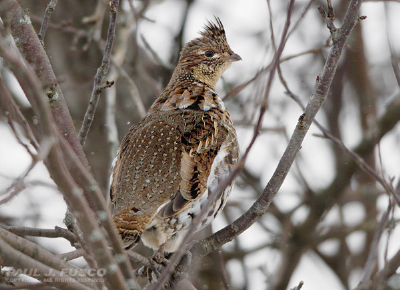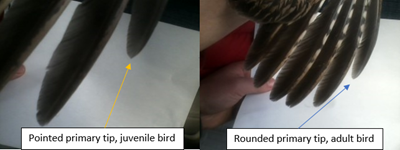Ruffed Grouse Hunter Log

To develop a better understanding of hunter effort and grouse population dynamics, the Wildlife Division is asking hunters, regardless of harvest success, to participate in a voluntary hunt reporting program. Data collected will allow biologists to better track trends in ruffed grouse populations throughout the state, provide hunter effort and success statistics, and prioritize land management.
Interested hunters are asked to log basic details such as: type of property hunted, town, hours hunted, flushes seen/heard, and harvest information for hunts in Connecticut. Reports can either be entered on this online form or submitted on paper through scan/email or post at the conclusion of the season. The form will request hunters to determine age and sex of their harvested birds using the information on this page.
Sexing and Aging Grouse
The age and sex of harvested birds can be determined by watching the Ruffed Grouse Society video or reviewing the information below. Should you have any questions or difficulties, or wish to submit a photo directly, please contact Will Cassidy at william.cassidy@ct.gov or 860-418-5961.
Sexing

The sex of a grouse is determined by looking at the rump and tail feathers and taking some simple measurements.
If there is an unbroken band across the tail fan, the grouse is male. This pattern can vary in some males, so this method is not accurate if the band is not unbroken.
Plucking and measuring one of the middle two tail feathers may be more definitive.
If the overall length of a feather is greater than 5 7/8" the bird is male, less than 5 1/2" and the bird is female.
Another option is to pluck or isolate a tail covert on the rump. Females will only have one dot on a covert, males (below, right) will have two or more.


Aging

Aging grouse is accomplished by studying the flight feathers or primary feathers on the wings. To tell a juvenile from an adult, the eighth, ninth, and tenth primaries at the leading edge of the wing are key.
Adults will replace all 10 primaries yearly but juveniles will not replace the ninth or tenth by the fall.
If a bird is harvested when the ninth and tenth primaries are growing back in on both wings, it is an adult bird.
A bird harvested with all primaries having smooth rounded edges is also an adult bird.

Juvenile birds will have pointed or narrow tips, with worn or ragged edges on the ninth and tenth primaries.
If you cannot determine a bird's age by looking at the edges of the primary feathers, pull the eighth and ninth or tenth primaries and observe the remnants of sheathing left on the quill or calamus (the translucent base of the feather).
If the ninth or tenth primary has the same amount of remnant sheathing as the eighth, the bird is an adult. If the ninth or tenth primary is clean, the bird is a juvenile.

For more information on the life history of ruffed grouse in Connecticut, please view the Ruffed Grouse fact sheet.
Content last updated in August 2022.

